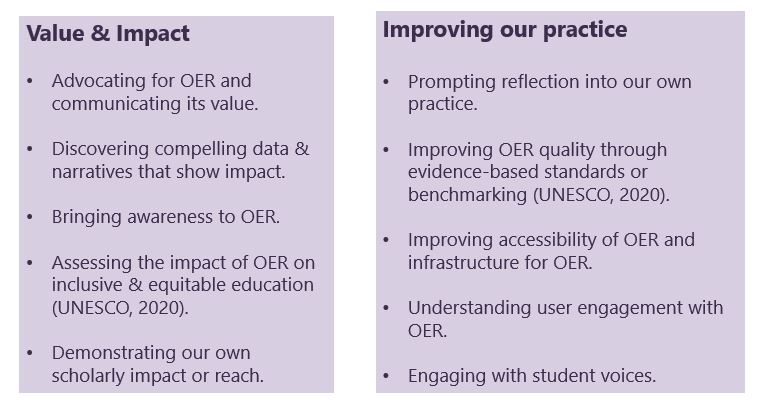29 Assessing Impact, Value and Reach
Why does evidence on OER matter?
Evidence can be used to prove value and impact, or identify improvements for your OER.

Assessing Impact, Value and Reach
Downloads, shares and views are one good indicator of the reach your open text is having outside the institution, so please take advantage of your data dashboard. However, please note there are other indicators of quality, reach, value and impact:
- peer review
- student savings
- number of downloads
- adoptions
- adaptions
- media mentions
- course enrolments
- course completions
- social networking contacts
- increased student diversity
- grants funding
- student success
- mention by policymakers
- student retention
- trending in social media
- student surveys
- student testimonials
- trust/reputation
- blog mentions
- number of citations
- faculty recommendations
- faculty award/prize
- influencing curriculum creation
- influencing the textbook market
- participating in public education programs
- invitations to present
- invitations to consult
- change in policy
- change in processes or behaviour
- rankings/promotion
- thank you cards from students, parents or staff.
Assessing the impact, value and reach of your open text can enable career and research opportunities.
References
UNESCO. (2022). Guidance on Open Educational Practices During School Closures: utilizing OER under COVID-19 in line with UNESCO OER recommendations. https://iite.unesco.org/wp-content/uploads/2020/05/Guidance-on-Open-Educational-Practices-during-School-Closures-English-Version-V1_0.pdf
Chapter Attribution
This chapter has been adapted in part from:
- ’56 indicators of impact’ by J Britt Holbrook, Kelli R. Barr, Keith Wayne Brown, licensed under a CC BY 4.0 licence.
- ‘Measuring the Impact of your OER,’ by Emilia Bell. Reproduced with permission.

